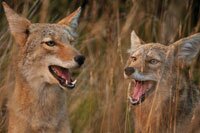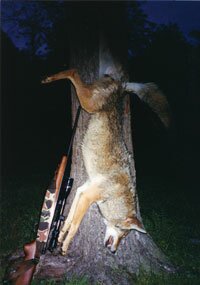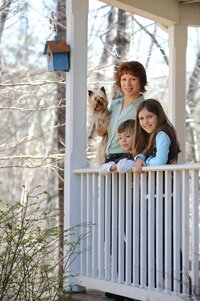COVER- Invasion of the doggy snatchers? Uptick in area coyote sightings has residents nervous

Coyote skull: When alive it roamed the North Garden area.
PHOTO JEN FARIELLO
An animal known for eating domestic pets has arrived in Albemarle, and reports from around the country suggest it's moving up the food chain.
A Minnesota woman watched helplessly last month as coyotes killed Callie, her miniature Pinscher, in her backyard. That same week in Broomfield, Colorado, Amy Archibald let her four tiny Papillons out in her backyard. Thirty seconds later, one named Ollie was gone.
In early March, a farmer in Winston-Salem claims his cow was killed and eaten by a coyote. And in Colorado, a state no stranger to coyotes, five attacks on people were reported over the winter in the Denver metropolitan area.
Residents in Albemarle's Stony Point area were alarmed to hear that a pet dog may have been attacked by a pack of coyotes in February, and the Department of Game and Inland Fisheries confirms that coyotes have moved into Central Virginia– including suburban Albemarle.
Buddy, a 90-pound Labrador in Mary Cox's Turkey Run neighborhood, was attacked February 19 in what initially was believed to be a dogfight, says Cox.
The morning after the attack, Buddy's owner spotted at least three and possibly five dog-like mammals with bushy tails and snouts that, based on research he'd done, he thought were coyotes, says Cox. Buddy's owner declined to comment for this article.
"Definitely, we're concerned," says Cox. "I've got a dog that's outside and kids that play outside."
Whether Buddy's attackers were dogs or coyotes, Sergeant Kenny Dove with the Virginia Department of Game and Inland Fisheries says he has no way of knowing. But one thing Dove is certain about: Coyotes have definitely arrived in Albemarle County.
Canis latrans–- barking dog–- is a highly adaptable species that has expanded its native Canadian range into all 49 continental states and Mexico. Dove knows of several confirmed sightings in the Shenandoah Valley, and he followed game department reports as they were first sighted in southern Albemarle, and then in the northern part of the county.
"They can urbanize," says Dove, "and they're opportunistic."
At 30 to 35 pounds, coyotes are smaller than wolves. They can hunt in packs–- or in pairs. Sheep farmers and hunters are often the first to know if coyotes are in the area, but the canine cousins of dogs don't limit themselves to killing animals in rural settings.
"They are so good at what they do," says Dove. "We don't want them here."
Indeed, Virginia allows coyote hunting without a license or permit every day of the week except Sunday. And there's no catch limit. The Department of Game and Inland Fisheries doesn't have a number on the coyote population in Virginia, but it's witnessed a rise in live coyote sightings as well as in dead coyotes, often as road kill.
"We know they're increasing," says Mike Dye, a wildlife biologist in the DGIF. "Coyotes are not native to Virginia. That's one reason they're listed as a nuisance species."
One theory on their arrival is that as their natural predator, the wolf, was decimated to near extinction, coyotes moved across Canada and down the Appalachian range. Coyote attacks are now reported all over the country.
"Previously, wolves were putting pressure on them," says Dye. "Now, man is the only predator."
Game department master conservation officer Steve Ferguson investigated the Stony Point attack. Coyotes?
"I can't say that it was," he says. "I can't say that it wasn't."
Ferguson finds it odd that a 35- to 45-pound coyote would take on a 90-pounder like Buddy, who has recovered from the attack. "Maybe for a pack..." he muses. "It could be a territorial issue or a food issue. Or it could have been dogs. The wounds were consistent with dogs–- but they're all related."
A year ago, a Crozet woman claimed she'd repeatedly spotted a cougar in her yard–- a claim that got no traction with the game department. With coyotes, there's no such skepticism.
Even if coyotes weren't Buddy's attackers, the department's Ferguson says he has seen two live coyotes since he's moved to Albemarle in 1994 and many more that hunters have killed.
Ferguson, who lives not far from the Stony Point neighborhood where Buddy was attacked, says, "I've actually heard them at my house."
So has Joe Ford in White Hall.
"Typically, you can sit on my front porch and hear 'em at least once a week," says Ford, who estimates he's seen them between 20 and 30 times. "I've seen 'em on Garth Road. And a lot of my buddies have killed 'em."
Twenty years ago, no one would have believed coyotes were in Albemarle, says builder Steve Kirschnick, an Albemarle native who reports sightings in Ivy, Earlysville, Scottsville, and Fontaine Avenue. Now, he says he wouldn't be surprised to spot a coyote behind the Rite Aid on Pantops, where he's building townhouses.
"Anyone who spends time in the woods is going to see them," says Kirschnick, a hunter who's killed around a dozen coyotes. "We do a lot of bow hunting," he says. And when hunters do turkey calls, coyotes show up.
The coyotes Kirschnick has seen average about 25 pounds, and the largest he's bagged was 41 pounds, 6 ounces. He put up a "coyote cam" near his Keene home, and caught one of the nocturnal creatures on film.
"They're very vocal at night," says Kirschnick, who describes their bark as similar to the yipping of a terrier, while they're about the size of a border collie. Often, the first time a hunter spots a coyote, he's hesitant to shoot, observes Kirschnick. "People," he observes, "don't want to shoot somebody's dog."
Coyotes hunt by smell, and the scent of a human sends them into skedaddle mode, according to Kirschnick.
"If they smell you, they take off," he says. "They don't sneak away. They bolt. If one smells you, it runs away yipping because it's frightened."
He's dubious about the notion that coyotes hunt in packs. His experience is that they travel solo, unless it's mating season or they're cubs who haven't yet gone their own way.
As a hunter, Kirschnick appreciates the thrill of bagging such an exotic (for now) trophy, but he'd rather they not become the latest species to find Albemarle a desirable place to live.
"I don't like the idea of them here because they're going to eat our small game," he declares. "They're going to eat our turkeys. It's a balance, and coyotes come in and can decimate them."
Last July, residents of Naples, Florida, were already on edge after officials warned them about coyote sightings. But what happened to Caesar, a cat that refused to come inside one night, turned worry into horror.
Security cameras on the property of Naples resident Carol Dinwiddie showed a coyote calmly stalking Caesar. When the cat tried to flee up a tree, the coyote followed. The result was fatal.
Dove from the Department of Game and Inland Fisheries stresses that coyote habitation doesn't have to be a cause for panic.
"I would be more concerned about stray dogs than coyotes," says Sergeant Dove.
Still, he strongly advises against leaving pet food outside, and he notes that along with livestock, coyotes look at cats and small dogs as prey.
"If you've got a 10-month-old baby, you wouldn't leave it out in the yard," says Dove. "And you teach children not to approach wild animals."
Mary Cox is used to letting her children play down by the creek. "I have to worry about the creek being too deep," she says. "I never thought about wildlife. I guess I should."
But to Ferguson, public unawareness indicates how little a safety threat coyotes are. "Farmers and hunters know they're here," he says. "Otherwise, people don't know they're here."
At least until cats start disappearing.

They live among us. Coyotes have taken up residence in Albemarle County.
PHOTO BY MATT KNOTH/FLICKR

Except on Sundays, it's always hunting season on coyotes, a varmint Virginia game officials emphatically don't want here.
PHOTO COURTESY STEVE KIRSCHNICK

This coyote was killed in the Keene area during winter 2007.
PHOTO COURTESY STEVE KIRSCHNICK

Steve Kirschnick holds the skin of a 31.5-pound coyotes killed in the North Garden area last November.
PHOTO JEN FARIELLO

Mary Cox keeps a closer eye on her Yorkshire terrier, Lacie, and Kevin, 9, and Kinsey, 10, in their Stony Point neighborhood where a 90-pound Lab was attacked.
PHOTO JEN FARIELLO
#
12 comments
Not "decimated," but "devastated." "Decimated" means a loss of one tenth. From the latin for ten.
Pet peeve.
Pull the Sunday restriction off of shooting coyotes. These things are eating machines, breed like rabbits, and carry disease. Take all restrictions off of the hunters.
Reality, Are you saying coyotes only come out on sunday? Didn't know they were church going creatures!
For a moment I thought you were describing people. ;)
Nope Vertico, I'm saying they come out on Sunday as well.
I would have liked to see a pitbull skull next to the coyote's so we have a comparison. The coyote skull in the photo seemed to have healthy teeth.
Don't shoot the deer because they are cute! Shoot the "yote" because he will eat your yorkshire terrier. I say keep the coyote to solve the deer problem, no wait, import wolves to solve the coyote problem. Oh no, wolves eat yorkies too. dang, it's all the turkeys and squirrels attracting the prey animals so get rid of them! Oh jeez the DNR is behind the curve and not issuing enough tags! Let's have another meeting to discuss the problem. Hey, whats a feral pig? That's it by george, let's import feral pigs to feed the coyotes so they will leave the yorkshire terriers alone! Blay, Blah, Blah, why don't you get government out of the picture and stop developing into wildlife habitat? But if develop you must, stop complaining. Enjoy your wild neighbors, you will learn something that may make you respect and admire them.
Yes we need to do something about the coyote but if you have animals that are your pets and you love them, keep them inside and safe. Please don't turn them loose for the coyote and whatever else is out there to get them. You got these pets and taught them to love you and depend on you, now take care of them. Thanks
Is there any scent that can be put (safely) on a pet cat or dog so that a coyote wouldn't be attracted to it?
I was walking our then puppy on a dirt road in Shenandoah co. & one came up out of the woods & followed us about ten feet from us for about 100 yards before bounding back in the woods. this was September of 08......Was it rabid ? hungry ? Who knows.
Ran into a coyote at about 6pm a couple months ago in the backyard. One of our cats was within twenty yards of it, thankfully I looked out the window in time. I ran out into the yard to scare it away, and the coyote was less than impressed with me. It stopped in it's tracks and pretty much sized me up. Then is slowly walked away.
These things are hunting our livestock and animals. Take them out whenever you see them.
I was out hunting this past Saturday and was on my stand at approx. 5:15am when I heard a pack of coyotes attacking a deer or something. It was incredible and I will never forget the sound as long as I live! It reminded me more of a pack of hyenas than wolves. They had very high pitched voices and would get more excited as they closed in on whatever it was they were after. When they caught it there was another level of excitment still and I could hear them fighting over the meal as they tore it apart. We have seen Coyotes every so often and a friend of mine has even killed one, but I have never heard such a thing as what I heard that Saturday morning. It made the hair stand up on the back of my neck. Oh, and I never saw a deer that morning either...
I killed my first coyote two weeks ago in the GW National Forest in Rockingham County. Female weighing about 35 pounds, and suffering pretty badly from mange. I was deer hunting at the time, and she crossed in front of me about 25 yards away.
Coyotes have been in the Albemarle area for at least ten years, as I used to hear them when visiting friends in Rivanna. They have been in the GW National Forest for almost THIRTY years, as I saw them when backpacking as a teenager in the late 70's early 80's. Back then VDGIF kept denying their existence, despite confirmed sightings, scat, and tracks. They're doing the same thing now with cougars, who have been in the western part of VA for at least ten years. VDGIF likes to keep their head in the sand, so that they don't have to develop an actual management program for the big cats.
The DC suburbs aren't immune, either. I live just inside the Beltway, and we have coyotes roaming the stream valley park behind our neighborhood. This past summer, there were a lot of "lost dog" and "lost cat" posters on telephone poles in the area. Most of the dogs on these flyers were small dogs.
Just wait, you'll have them in your neighborhood pretty soon!
John